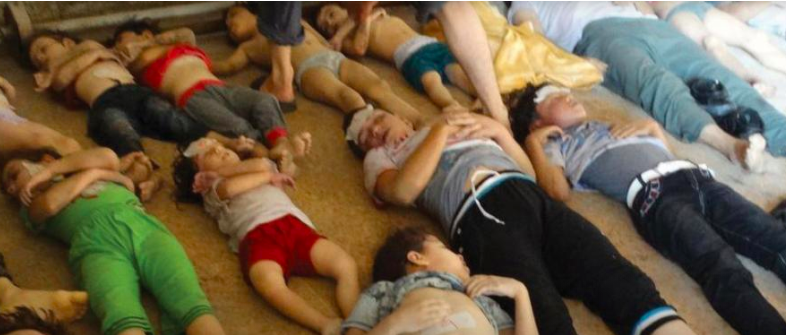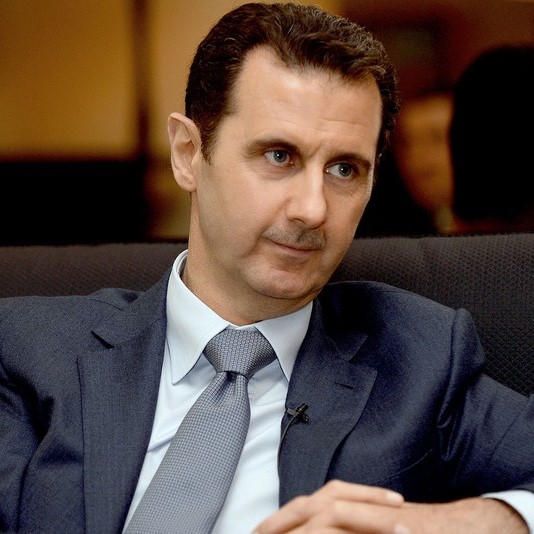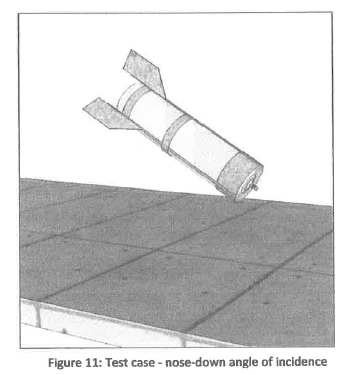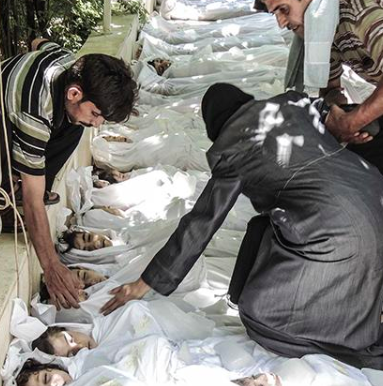
In the long-running nightmare of the Syrian civil war, the attack at Douma was a déjà vu atrocity with big consequences in Washington.
On April 7, 2018, a working class neighborhood in greater Damascus suffered a chemical attack that killed at least 43 people. Six days later, President Trump ordered a cruise missile attack on a research center and a chemical weapons facility that had been used for the production of sarin. The Douma attack, declared President Trump, represented “a significant escalation in a pattern of chemical weapons use by that very terrible regime,” alleging inaccurately that sarin gas has been used. Trump’s retaliation won him rare bipartisan praise in Washington and the news media.
Ever since Western critics and Russian media outlets have charged the Douma attack was actually a “false flag” operation, orchestrated by anti-regime forces, to provoke and justify U.S. intervention in Syria’s civil war.
Now the critics cite a leaked email and testimony of a current inspector from Organisation for the Prohibition of Chemical Weapons (OPCW) to make their case. An OPCW inspector, speaking pseudonymously as “Alex,” says the agency’s March 1, 2018 report on the Douma attack was “seriously misleading.” In conjunction with a complaint of an OPCW analyst last spring, “Alex’s” claim opens the possibility that the OPCW made a mistake in attributing the attack to the Assad government.
Fox News provocateur Tucker Carlson says the Douma attack may have never happened, which is false. Scores of Syrian citizens certainly died in Douma . The question is, Who was responsible?
The Douma attack cannot be assessed in isolation. There is little doubt that the Assad government is responsible for most of the reported chemical attacks in Syria, whether by chlorine or sarin gas. In April 2018 Human Rights Watch found that in 85 confirmed chemical attacks, investigators found that government was responsible for 50. Four were attributed to non-government forces. The perpetrators of the remainder could not be determined. The false flag allegation has only been raised in a handful of cases.
The Douma debate echoes a similar debate about a sarin gas attack in August 2013 that killed at least two hundred people in Ghouta, the same municipality that encompasses Douma. The Ghouta attack that famously crossed President Obama’s “red line” and lead to calls for a U.S. attack on Assad, which Obama declined to order. Some Western critics originally claimed, along with Russian state media, that Ghouta was a false flag operation designed to bring the United States into the civil war. That debate has petered out, as the evidence has accumulated to support the conclusion of a U.N. investigation that the Syrian government was responsible.
The Douma debate matters because Syria matters. Despite President Trump’s orders, the U.S. troops have not fully withdrawn from Syria. Most of the Democratic candidates blasted Trump for his decision. The lone exception is Tulsi Gabbard, the most vocal critic of U.S. foreign wars in the Democratic field. Her web site expresses skepticism that the official story on Douma but does not endorse any theory. Critics have smeared Gabbard as a Russian agent, a claim for which there is no evidence.
The false flag allegation cannot be dismissed as mere Russian propaganda. In my coverage of chemical attacks, Russian intelligence services, and CIA false flag operations, I’ve learned not to rule out any claims on grounds of propaganda. Nor do I reject the claims of Gabbard and other critics because they oppose U.S. intervention in the Syrian conflict. I oppose it too. Like Louis Proyect at Counterpunch, I do not see any evidence proving that Douma was a false flag incident.
The debate, as conducted within the binary dictates of social media, is simplistic. Just because the official story may be flawed doesn’t mean that any alternative theory must be right. While the OPCW’s findings are now open to question, the critics’ explanation of the Douma attack is in no way proven. Tucker Carlson’s take is, once again, fallacious.
The two OPCW whistleblowers do not say, and do not provide any evidence–much less proof–of the critics’ alternative scenario:s that the Douma attack didn’t happen or was a “managed massacre,” perpetrated by anti-regime rebels and supported by the United States.
The OPCW’s finding of a Syrian government attack, while contested, remain more credible than the “managed massacre” or “never happened” scenarios, which are not merely improbable, but preposterous. The complexities of the Douma evidence defy the social media binary.
Assad War Crime?

There is little dispute that on April 7, 2018, an apartment building near Martyr’s Square in Douma, a poor suburb of Damascus, was attacked at around 7:30 pm local time, resulting in multiple deaths, apparently from asphyxiation.
“Casualty levels ranging from 40 to 70 deaths, including large numbers of children,” said the OPCW’s March 1, 2019 report. “Most them were “seen in videos and photos strewn on the floor of multiple levels of an apartment building and in front of the same building. Additionally, several witnesses reported seeing decedents in the basement of the building, on multiple floors of the building, on the streets and inside the basements of several buildings within the same area.” One UN team reported “cases of death by exposure to a toxic chemical” but did not actually examine the bodies so the claims was not confirmed.
The OPCW fact-finding team, which arrived on the scene two weeks later, concluded that a 360 pound missile had penetrated the roof of the building and landed in a top floor apartment, releasing some kind chlorinated chemical that killed 35 residents, including 18 on the first floor and 10 on the second.
The OPCW report concluded:
all the information gathered by the FFM [Fact Finding Mission]—witnesses’ testimonies, environmental and biomedical samples analysis results, toxicological and ballistic analyses from experts, additional digital information from witnesses—provide reasonable grounds that the use of a toxic chemical as a weapon took place. This toxic chemical contained reactive chlorine.
The OPCW, in short, endorsed the widely reported story that Douma was the site of a chemical attack and the Assad government was responsible.
It turns out, however, that the OPCW’s claim about “all the information” is not accurate.
Two Whistleblowers

Two employees have come forward to dispute aspects of the OPCW report.
Last spring. Ian Henderson, an OPCW analyst who reviewed the work of the fact finding team, disputed the conclusions about the angle at which missile that hit the building. He raised the possibility that the missile had been placed on the top floor of the building where dozens were found dead.
[Last June, I wrote about Henderson’s complaint.]
The second OPCW whistleblower, acting under the pseudonym “Alex,” has made public a June 22 email that he sent to a senior OPCW official named Bob Fairweather (a marvelous moniker for a U.N. bureaucrat.)
The report “seriously misrepresents” the facts, “Alex” said. “Crucial facts” had been distorted he said. (Wikileaks has posted the email, which you can read here.)
“Alex’s” email adds detail and credibility to Henderson’s claims. At the very least, the OPCW’s public report did not accurately convey the private differences of opinion among the OPCW staff. These differences are not insignificant, according to Dr José Bustani, the first Director-General of the OPCW. After “Alex” gave testimony at a conference in Brussels last week, Bustani said.
“The convincing evidence of irregular behaviour in the OPCW investigation of the alleged Douma chemical attack confirms doubts and suspicions I already had. I could make no sense of what I was reading in the international press. Even official reports of investigations seemed incoherent at best. The picture is certainly clearer now, although very disturbing.”
The complaint of “misleading edits” was heard Monday at the OPCW’s annual meeting. The OPCW declined to comment.
‘Managed Massacre?’
So if the Douma attack was not launched by the Syria government, who did it?
The most detailed answer comes from the Working Group on Syria, Propaganda and Media, a British-based group of researchers who dispute narratives of Western media and governments. They hypothesize the attack was “a managed massacre of captives, with a chemical attack staged by placing gas cylinders at the site and possibly opening them to release chlorine.”

The problem with this scenario is whistleblower “Alex.” He argues that there is insufficient evidence to say the victims died of chlorine poisoning. If “Alex” is correct, as the critics say, the 40-plus victims were not killed by chlorine. So how did they die?
The Working Group offers no explanation, only a link to a web site called Monitor of Massacre Marketing, which posits that “the killers and stagers, who brought the victims to this abandoned home from another, nearby location where they were gassed, largely upside down.”
This scenario is wholly imagined by someone who has perhaps seen too many horror movies. It depends on ignorance of the attack site and the belief that the putative authors of a false flag operation—supposedly an al-Qaeda linked militia in retreat from a ferocious Syrian government attack–could kill dozens of people known to their neighbors by means of an unknown gas and then transport the corpses through an urban war zone, and lug a 360 pound projectile up to the roof—all without detection by anyone.
There is no eyewitness testimony to support such a scenario. In a word, the “managed massacre” theory is preposterous.
So what explains the dissent of the OPCW whistleblowers? That’s a good question without a good answer.
Could the victims have been killed by a chemical agent unknown to OPCW experts? That seems unlikely. Could “Alex” be mistaken about the levels of chlorine found at the scene? That seems possible, though unlikely given his expertise. The doubts of qualified observers like former OPCW chief Bustani need to be addressed. The “false flag” theory, is not a credible explanation based on the available evidence.


